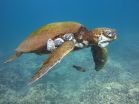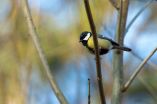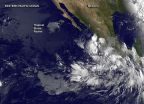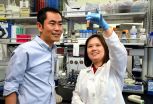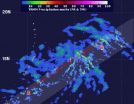(Press-News.org) DURHAM, N.C. -- Pollution in urban and farm runoff in Hawaii is causing tumors in endangered sea turtles, a new study finds.
The study, published Tuesday in the peer-reviewed open-access journal PeerJ, shows that nitrogen in the runoff ends up in algae that the turtles eat, promoting the formation of tumors on the animals' eyes, flippers and internal organs.
Scientists at Duke University, the University of Hawaii and the National Oceanic and Atmospheric Administration (NOAA) conducted the study to better understand the causes behind the tumor-forming disease Fibropapillomatosis, which is the leading known cause of death in green turtles, said Kyle Van Houtan, adjunct associate professor at Duke's Nicholas School of the Environment.
"We're drawing direct lines from human nutrient inputs to the reef ecosystem, and how it affects wildlife," said Van Houtan, who is also a scientist in NOAA's Turtle Research Program.
This research builds on a study published in 2010 that found the disease was more prevalent in areas with high levels of nitrogen runoff. That study hypothesized the disease might be linked to how algae that the turtles eat store extra nitrogen, and designed this study to test that idea.
"In this paper we drill down on whether excess nitrogen inputs are causing a nutrient cascade in the system that's ending up in these tumors in green turtles," said Van Houtan.
One way that algae store excess nitrogen is in an amino acid called arginine. The researchers found unusually high levels of arginine both in the algae in highly polluted waters and in the tumors of diseased turtles. Arginine levels in algae in less polluted waters and tumor-free tissues were comparatively low.
One non-native red algae species, Hypnea musciformis, had especially high levels of arginine compared to other species sampled. Hypnea is invasive and thrives in the nitrogen-rich waters caused by nutrient pollution. Since it grows more successfully than native species of algae, it can make up as much as 90 percent of the turtles' diet.
Because this algae contains so much arginine and the turtles eat so much of it, the turtles have approximately 14 times more arginine in their systems than they would if they were eating native algae species in less-polluted waters, said Van Houtan.
Even worse, the turtles, which are herbivorous, have to eat twice as much of the invasive algae species to get the same amount of calories they would gain from eating native algae.
"The energy and arginine content of (the algae) may therefore act as a sort of one-two punch for promoting this disease," the study noted.
Arginine is thought to promote a virus that leads to the disease that forms the tumors. "If this disease is a car, arginine its fuel," said Van Houtan. Without it, the virus can't function. How the virus causes tumors is still unclear, he said.
Arginine is just one of the molecules the researchers measured in the turtle tumors. They also found elevated levels of amino acids that are common in human cancer tumors, such as proline and glycine, Van Houtan said.
Measuring amino acids in the turtle tumors allowed the researchers to better understand how the tumors form and function. Similar analyses of amino acids may also be useful in understanding human cancer tumors, said Van Houtan. "A hallmark of cancer tumors is that they re-program their host cells and change their metabolism. Our findings here are similar."
This research could help scientists better understand how to protect not only sea turtles but also other marine plants and animals that face similar threats from pollution. "It's not just green turtles, but fish and coral reefs that have similar diseases in these locations," said Van Houtan.
Van Houtan said he hopes future research on this problem can inform environmental management of reef systems as a whole. "If research continues to support this hypothesis, we probably need to reconsider our current ways of managing coastal nutrients," he said.
INFORMATION:
The research was funded by a grant from the Disney Worldwide Conservation Fund and a Presidential Early Career Award in Science and Engineering.
Celia M. Smith, Meghan L. Dailer and Migiwa Kawachi of the University of Hawaii at Manoa co-authored the study.
Citation
"Eutrophication and the dietary promotion of sea turtle tumors," Kyle S. Van Houtan, Celia M. Smith, Meghan L. Dailer and Migiwa Kawachi, published September 30, 2014 in PeerJ. DOI: 10.7717/peerj.602
Pollution linked to lethal sea turtle tumors
High nitrogen levels in urban and farm runoff in Hawaii promotes a tumor-causing disease that is the leading known cause of death in endangered green sea turtles
2014-09-30
ELSE PRESS RELEASES FROM THIS DATE:
Adolescent exposure to thc may cause immune systems to go up in smoke
2014-09-30
When it comes to using marijuana, new research, involving mice and published in the October 2014 issue of the Journal of Leukocyte Biology, suggests that just because you can do it, doesn't mean that you should. That's because a team of Italian scientists have found that using marijuana in adolescence may do serious long-term damage to the immune system. This damage may result in autoimmune diseases and chronic inflammatory diseases, such as multiple sclerosis, inflammatory bowel disease and rheumatoid arthritis in adulthood.
"I hope that the knowledge that early exposure ...
Cancer therapy: Driving cancer cells to suicide
2014-09-30
Researchers of Ludwig-Maximilians-Universitaet (LMU) in Munich report that a new class of chemical compounds makes cancer cells more sensitive to chemotherapeutic drugs. They have also pinpointed the relevant target enzyme, thus identifying a new target for anti-tumor agents.
Researchers led by LMU's Professor Angelika Vollmar and Professor Stephan Sieber of the Technische Universität München have identified a class of chemicals that represent a potential new weapon in the fight against malignant tumors. The compound is itself non-toxic, but it stimulates the killing ...
Scientists identify which genes are active in muscles of men and women
2014-09-30
If you want your doctor to know what goes wrong with your muscles because of age, disease or injury, it's a good idea to know what "normal" actually is. That's where a new research report published in the October 2014 issue of the FASEB Journal comes in. In the report, a team of scientists produce a complete transcriptome—a key set of molecules that can help scientists "see" which genes are active in an organ at a particular time. What's more, they found never-before-detected gene activity and that men have approximately 400 more active genes in their skeletal muscle than ...
Synthetic sperm protein raises the chance for successful in vitro fertilization
2014-09-30
Having trouble getting pregnant—even with IVF? Here's some hope: A new research report published in October 2014 issue of The FASEB Journal, explains how scientists developed a synthetic version of a sperm-originated protein known as PAWP, which induced embryo development in human and mouse eggs similar to the natural triggering of embryo development by the sperm cell during fertilization.
"We believe that the results of this study represent a major paradigm shift in our understanding of human fertilization by providing a precise answer to a fundamental unresolved scientific ...
Genetic test for cancer patients could be cost-effective and prevent further cases
2014-09-30
Screening for a genetic condition in younger people who are diagnosed with bowel cancer would be cost-effective for the NHS and prevent new cases in them and their relatives, new research has concluded.
Researchers at the University of Exeter Medical School were funded by the National Institute for Health Research Health Technology Assessment (NIHR HTA) Programme to assess the effectiveness and cost-effectiveness of screening for Lynch Syndrome. Their findings, published in Health Technology Assessment, indicate that screening the 1,700 people under the age of 50 who ...
Risky metabolism
2014-09-30
This news release is available in German.
Animals often differ in their behavioural response to risky situations such as exposure to predators. Researchers from the Max Planck Institute for Ornithology now found in a long-term study on different populations of great tits that risk-taking behaviour correlates with both metabolic rate and ambient temperature. High metabolic rates and low temperatures were associated with high risk-taking behaviour, as in these scenarios birds were more likely to approach potential predators.
The readiness to take a risk is to a ...
New blood test determines whether you have or are likely to get cancer
2014-09-30
A new research report published in the October 2014 issue of The FASEB Journal may make the early detection of cancer as easy as a simple blood test. This test, called the "lymphocyte genome sensitivity" (LGS) test, could not only detect some cancers earlier than ever before, but it may eliminate the need for some types of biopsies, as well as identify those more likely to develop cancer in the future.
"The test could allow earlier cancer detection, so helping to save peoples' lives," said Diana Anderson, a researcher involved in the work from the School of Life Sciences ...
Tropical Storm Rachel dwarfed by developing system 90E
2014-09-30
Tropical Storm Rachel is spinning down west of Mexico's Baja California, and another tropical low pressure area developing off the coast of southwestern Mexico dwarfs the tropical storm. NOAA's GOES-West satellite showed the size difference between the two tropical low pressure areas.
NOAA's GOES-West satellite captured an image of the Eastern Pacific Ocean on Sept. 30 at 1200 UTC (8 a.m. EDT). In the infrared image, Tropical Storm Rachel appeared small in comparison to the low pressure area called System 90E, coming together hundreds of miles south. As Rachel spins down ...
Virginia Tech researchers discover potential biomarker to detect 'bubble boy' disorder
2014-09-30
Many people recognize "the bubble boy" as an unusual character from a "Seinfeld" episode or a John Travolta movie.
But in reality, a genetic disease called SCID, short for severe combined immunodeficiency, forces patients to breathe filtered air and avoid human contact because their bodies' natural defenses are too weak to fight germs.
Although it affects fewer than 2,000 new births each year worldwide, SCID is a cousin to acquired immune deficiency syndrome triggered by a human immunodeficiency virus — HIV/AIDS.
Now, using a mouse model, Virginia Tech researchers ...
NASA's TRMM satellite sees Tropical Storm Phanfone fragmented
2014-09-30
The bands of thunderstorms wrapping around Tropical Storm Phanfone in the Northwestern Pacific Ocean appeared fragmented to NASA's TRMM satellite.
On Sept. 30, a typhoon watch remains in effect for the far northern Marianas Islands including Pagan and Alamagan. Tropical storm warnings have been cancelled for Tinian and Saipan, but remain in effect for Pagan, Alamagan and surrounding waters. A flash flood watch remains in effect for the island of Saipan. For updated forecasts for these islands, visit the U.S. National Weather Service Office's Guam website: http://www.prh.noaa.gov/guam/cyclone.php.
On ...
LAST 30 PRESS RELEASES:
Myosin XI-1: A key molecular target for salt-tolerant crops
Pusan National University study highlights the health hazards of ultrafine particles from small home appliances with electric heating coils and brushed DC motors
Global first: New Indigenous-led research initiative to revitalize legal orders
Transforming acoustic waves with a chip
When climate risk hits home, people listen: Study reveals key to engagement with disaster preparedness messaging
Major breakthrough against diabetes thanks to a microbial molecule that disarms inflammation
Silicon chips on the brain: Researchers announce a new generation of brain-computer interface
Getting rest is the best
Towards sustainable organic synthesis – Mechanochemistry replaces lithium with sodium in organic reactions
Wireless device ‘speaks’ to the brain with light
Greenhouse gases to intensify extreme flooding in the Central Himalayas
New study sheds light on Milky Way's mysterious chemical history
Could altering the daily timing of immunotherapy improve survival in people with cancer?
Weaving secondary battery electrodes with fibers and tying them like ropes for both durability and performance
Using social media may impair children’s attention
Science briefing: An update on GLP-1 drugs for obesity
Lower doses of immunotherapy for skin cancer give better results
Why didn’t the senior citizen cross the road? Slower crossings may help people with reduced mobility
ASH 2025: Study suggests that a virtual program focusing on diet and exercise can help reduce side effects of lymphoma treatment
A sound defense: Noisy pupae puff away potential predators
Azacitidine–venetoclax combination outperforms standard care in acute myeloid leukemia patients eligible for intensive chemotherapy
Adding epcoritamab to standard second-line therapy improves follicular lymphoma outcomes
New findings support a chemo-free approach for treating Ph+ ALL
Non-covalent btki pirtobrutinib shows promise as frontline therapy for CLL/SLL
University of Cincinnati experts present research at annual hematology event
ASH 2025: Antibody therapy eradicates traces of multiple myeloma in preliminary trial
ASH 2025: AI uncovers how DNA architecture failures trigger blood cancer
ASH 2025: New study shows that patients can safely receive stem cell transplants from mismatched, unrelated donors
Protective regimen allows successful stem cell transplant even without close genetic match between donor and recipient
Continuous and fixed-duration treatments result in similar outcomes for CLL
[Press-News.org] Pollution linked to lethal sea turtle tumorsHigh nitrogen levels in urban and farm runoff in Hawaii promotes a tumor-causing disease that is the leading known cause of death in endangered green sea turtles
